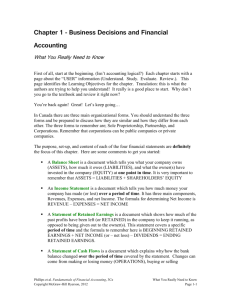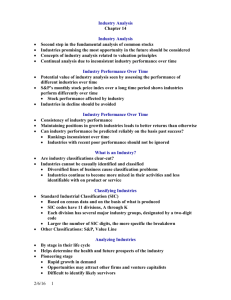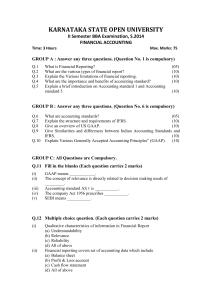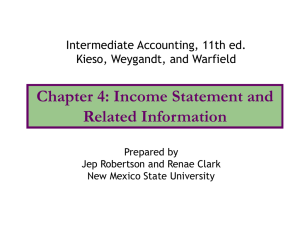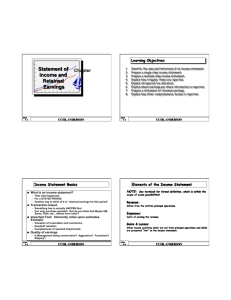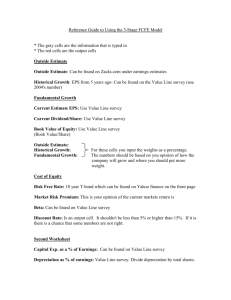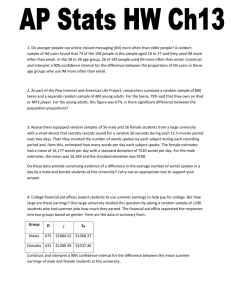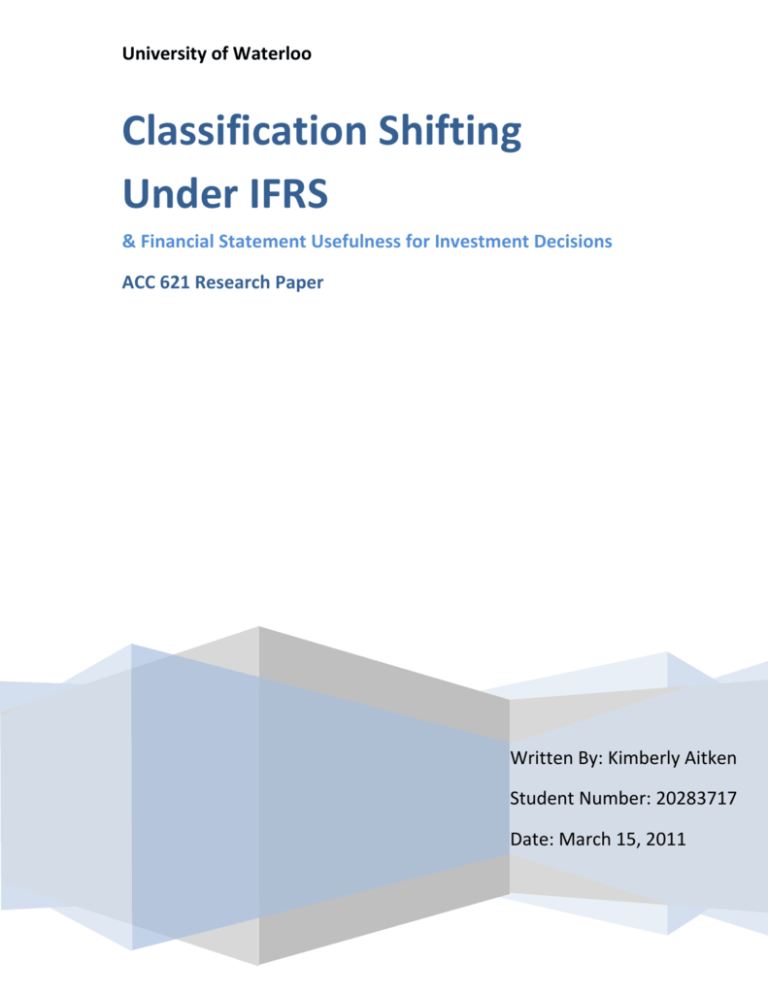
University of Waterloo
Classification Shifting
Under IFRS
& Financial Statement Usefulness for Investment Decisions
ACC 621 Research Paper
Written By: Kimberly Aitken
Student Number: 20283717
Date: March 15, 2011
1.0 Introduction
Investors must rely on publicly available information in order to assess the performance and
financial position of a company and make investment decisions. However a majority of the
available information is prepared by the company‟s management who may have personal
incentives to report stronger performance (i.e. to increasing the bonus those managers receive, to
keep their job and to maintain their reputation as a good manager). It is often in the best interest
of those preparing company information to show strong performance. Public companies have a
bias towards reporting growth and strong net income in order to attract investors and to reduce
the chance of unwanted, negative analyst and media attention. Private, owner-managed
companies may also have an incentive to report strong financial position and performance in
order to gain additional financing or to keep existing financing (i.e. not violate their debt
covenants). This bias can make it into a company‟s financial statements in the form of the
accounting policy choices, estimates made by management and potentially through opportunistic
earnings management, reducing the usefulness of the financial statements for the users.
The degree of usefulness of financial statements to potential investors could mean the
difference between a good investment decision and a bad one. Financial statements are useful to
investors when they provide the investor with information that is relevant to their investment
decision and that information is reliable (Scott, 2009). Therefore it is in the best interests of
investors to not only understand the financial statements, but to be aware of management‟s
possible bias and how that bias could impact the financial reporting of the company being
assessed. As Canada makes the transition to International Financial Reporting Standards (IFRS)
from Canadian Generally Accepted Accounting Principles (GAAP), users of financial statements
must learn the new standards in order to assess financial statements and make investment
decisions, but also should become familiar with how the change in accounting standards could
1
alter the impact of management‟s bias in financial reporting. This paper will discuss the practice
of classification shifting as a method of managing earnings and the impact of the change to IFRS
on this practice. By analyzing research conducted in the United States (US) and the United
Kingdom (UK) and applying those findings to the change in Canadian accounting standards, this
paper argues that IFRS reduces the ability of a company‟s managers to manage earnings through
classification shifting, thus increasing the usefulness of financial statements for investment
decision-making.
2.0 Earnings Management
Earnings management is “the misrepresentation or masking of true economic performance”
(McVay, 2005). Thus, earnings management is used by managers to misstate the performance of
their company for any number of possible reasons and could result in financial statements that
are less useful for investors in making investment decisions. Earnings can be managed through
accrual management, real activity management and classification shifting (Barua, Lin &
Sbaralia, 2009), each with its own financial impact and consequences.
“Classification shifting involves reporting revenues, expenses, gains, and losses on different
lines on the income statement other than those on which they should properly appear under
GAAP” (Barua et al., 2009) or IFRS. Since this method of earnings management results in nonIFRS (or non-GAAP) financial statement presentation and reporting, any material shifting would
result in financial statements that are materially misstated. Thus it is likely that financial
statement users would make different decisions with the impact of classification shifting than
would be made if the statements were reported in accordance with IFRS (or GAAP). However,
classification shifting may be less costly to the company and less scrutinized by auditors
(McVay, 2005) as such earnings management does not result in a change to net income (Barua et
al., 2009). Along with the fact that the net income reported by the company is the same with or
2
without classification shifting, the effect of the earnings management through classification
shifting does not reverse in the next period (as it does when accrual management is used). For
example, management could shift an operating expense to discontinued operations. This would
result in higher income from operations, income from continuing operations and core earnings,
while having no effect on the reported net income (Barua et al., 2009). As it has been found that
investors recognize that earnings closer to sales on the income statement are more informative of
future performance, altering the results above income from continuing operations can result in a
different perception and valuation of the firm by the financial statement users (McVay, 2005).
Use of both accruals management and real activity manipulation are more costly methods of
managing earnings than classification shifting and potentially more likely to be scrutinized by
auditors and financial statement users. The use of accruals to manage earnings is not feasible in
the long term as accruals reverse in future periods and thus result in reduced net income in the
period following the accrual. Accrual management also violates GAAP and/or IFRS and alters
the reported net income, and thus tends to be an area that is scrutinized by auditors, especially
since research in the area of earnings management has focused mainly on accruals management
and real activity management to date (McVay, 2005). Due to the publicity of accruals as a
method of managing earnings and the heightened regulatory environment of the post-SarbanesOxley world, auditors will focus on accruals in order to reduce the chance of missing a material
misstatement in the financial statements of a company being audited. On the other hand,
manipulation of real activity does not violate GAAP or IFRS and therefore would not be a focus
of auditors. However, real activity manipulation would hurt the future earnings of the company
and therefore be noted by investors and creditors in the future as the company‟s earnings
deteriorate. For example, if a technology firm that relied on research and development (R&D)
3
reduced the amount of R&D spending in the current year in order to increase current period net
income, the company would likely suffer from reduced future net income as development of new
ideas and products is slowed or potentially prevented due to lack of current R&D funding.
As research has focused mainly on accruals management and real activity management,
research in the area of classification shifting is fairly new (McVay, 2005) and thus less
understood or recognized by some financial statement users. Due to the reduced scrutiny placed
on classification shifting by auditors (as reported net income is not effected) and the lack of
analysis of such shifting by potential investors, classification shifting becomes an appealing
avenue for managers attempting to meet analysts‟ expectations, report growth or stability of core
earnings and/or increase the managers‟ compensation. As classification shifting is an attractive
method of managing earnings, further research of the practice and the impact on financial
statement users under different accounting standards could lead to better investment decisions.
3.0 Prior Research Findings
As much of the earnings management research has focused on accruals management and real
activity management, the research on classification shifting is more limited. However the
research studies on classification shifting do tend to support the findings of other research on the
topic. One of the first studies on classification shifting focused on analyzing “the allocation of
expenses between core expenses (defined as cost of goods sold and selling, general, and
administrative expenses) and special items” (McVay, 2005). The study used data from US
companies for firm-years between 1989 and 2003 (McVay, 2005) and thus the data would have
been constrained by US GAAP, section 225-20 for extraordinary and unusual items and, as of
August 2001, SFAS 144 for discontinued operations (CPAClass.com, n.d.). The study by McVay
based the hypothesis that “managers wishing to manage core earnings upward will shift expenses
that should be classified as core expenses to special items” (McVay, 2005) on previous research
4
findings regarding what financial statement users perceive as informative (McVay, 2005). As it
has been found that financial statement users distinguish between recurring and non-recurring
items based on their position in the income statement, classification shifting is made possible
(McVay, 2005). McVay found “empirical evidence supportive of classification shifting in the
form of a positive relation between income decreasing special items and unexpected core annual
earnings” (Fan, Barua, Cready & Thomas, 2009). McVay determined that on average, “…2.2
percent of reported special items…are actually current period operating expenses that are not
transitory but opportunistically classified as special…a mean shift of $287 thousand of recurring
expenses” (McVay, 2005). McVay also noted that classification shifting in the current year led
to negative subsequent year returns, consistent with investors reacting to the recurrence of
expenses previously excluded from core earnings (McVay, 2005). This implies that the
classification shifting in the current year reduced the usefulness of the current year financial
statements for investors, who react negatively to the reduced core earnings the next year.
McVay noted that her core earnings model was imperfect due to the inclusion of current year
accruals in order to control for company performance, which may include the accrual of special
items (McVay, 2005). Therefore, in response, further research was conducted by Fan, Barua,
Cready and Thomas (2009) with more performance controls in order to improve the core
earnings model and provided findings broadly consistent with McVay‟s results (Fan et al., 2009).
The research used quarterly data on US companies for firm years between 1988 and 2007 (Fan et
al., 2009) and thus the data would again have been constrained by US GAAP, section 225-20 for
extraordinary and unusual items and, as of August 2001, SFAS 144 for discontinued operations
(CPAClass.com, n.d.). Although the study found evidence opposing the expected positive
relationship between unexpected core earning and income-decreasing special items when
5
excluding current year accruals, after including other controls for firm performance, the results
supported McVay‟s findings as the negative relationship decreased significantly (Fan et al.,
2009). With evidence that classification shifting does occur through income-decreasing special
items, the study further found that the use of classification shifting increased in the fourth quarter
of the firm year, consistent with prior research findings that it becomes more difficult to
successfully manage earnings with accruals in the fourth quarter (Fan et al., 2009). This finding
suggests that classification shifting is less likely to be discovered in a year-end financial
statement audit, which is more thorough than the audit of interim quarter reports, compared to
the management of earnings through accruals and supports the findings of the Brown and Pinello
(2007) research (Fan et al., 2009). The research also found evidence that classification shifting is
more likely to be used by firms reporting results “…that just meet or beat analysts‟ forecasts,
one-year-ago same-quarter earnings and zero earnings…consistent with managers attempting to
avoid…negative consequences associated with missing earnings targets ” (Fan et al., 2009).
Overall, these results suggest that the year-end financial statements may not provide investors
with the most useful information, especially when the company was close to missing their
earnings targets. Thus, this research could be used by investors to become more sceptical of the
financial reports of companies that just meet or beat their earnings targets and therefore lead
investors to undertake more analysis on such statements before making an investment decision.
The two studies discussed above focused on the use of special items to engage in
classification shifting and thus increase core earnings. However, classification shifting can also
be accomplished through discontinued operations (Barua et al., 2009). The study conducted by
Barua, Lin and Sbaraglia (2009) focused on discontinued operations as a more beneficial
classification shifting tool for management compared to special items “…because shifting
6
operating expenses to discontinued operations also increases operating income, income from
continuing operations, and core earnings…[leading] to a higher stock valuation than increasing
core earnings alone” (Barua et al., 2009). The research report also pointed to the lack of detailed
disclosure of discontinued operations and the adoption of SFAS 144 as additional support of the
potential benefits to management of using discontinued operations, rather than special and
extraordinary items, as a means of classification shifting (Barua et al., 2009). The data used in
the study was based on US companies with firm years between 1988 and 2006 and therefore
constrained by the US accounting standards (section 225-20 and SFAS 144) and thus suggests
that the US standards make using and concealing classification shifting possible. This study
found a positive relationship “…between income-decreasing discontinued operations and
unexpected core earnings in the year a firm reports discontinued operations…” (Barua et al.,
2009) as well as “…a negative association between discontinued operations and the change in
unexpected core earnings in the year after a firm reports discontinued operations…” (Barua et
al., 2009). These results are consistent with managers shifting core expenses to discontinued
operations, which then recur in the following year in core earnings (Barua et al., 2009).
The Barua, Lin and Sbaraglia (2009) study does note that the company must be reporting a
discontinued item in order to utilize discontinued operations as an avenue to shift the
classification of core expenses (Barua et al., 2009). Therefore, the study reviewed the data for
firm years after the introduction of SFAS 144 in August 2001 to determine the effect of a change
in the accounting standards regarding discontinued operations on their findings (Barua et al.,
2009). They found that the “…recognition of discontinued operations significantly increased
after SFAS No. 144 became effective…” (Barua et al., 2009) while the “…results [also] suggest
a reduction in the magnitude of classification shifting using discontinued operations in the post-
7
SFAS No. 144 period” (Barua et al., 2009). Barua, Lin and Sbaraglia (2009) suggest that there
could be two potential reasons for the above findings. First, the change to SFAS No. 144
“…allowed smaller asset dispositions to be reported as discontinued operations, increasing the
reporting frequency… [but] potentially [reducing] the amount of operating expenses that can be
shifted to the disposition” (Barua et al., 2009). Alternatively, “…the Sarbanes-Oxley Act was
enacted around the same time as SFAS No. 144, and may have led to a decrease in classification
shifting due to increased regulation and oversight” (Barua et al., 2009). Therefore the change in
accounting standards in the US with the introduction of SFAS No. 144 did have an impact on the
use of classification shifting. However the reduced magnitude of the expenses shifted to
discontinued operations may have resulted in more useful financial statements for investors as
the amount shifted may not have had a material impact on the investors‟ decisions. Of course, the
amount of expenses actually shifted by a company and the materiality level of their financial
statement users would have to be assessed in order to determine if this inference is accurate, or if
the lower magnitude of classification shifting still resulted in investors making decisions that
they would not have made without the reported classification shifting.
The US findings of McVay, discussed above, were then used as a basis for further research of
classification shifting in the UK. The study by Athanasakou, Strong and Walker (2008) used data
from all the listed UK firms for the period of 1994 to 2002, “…following the enforcement of
FRS 3” (Athanasakou, Strong & Walker, 2008). The study found “…no evidence of a significant
association between TNRI [total non-recurring items] and unexpected core earnings…These
results suggest…classification shifting is not common practice among UK firms” (Athanasakou
et al., 2008). These results may be due to the transparency requirements under FRS 3 that call for
greater disclosure and specific presentation guidelines (Athanasakou et al., 2008). The study did
8
however find evidence of “…a subset of larger firms shifting small core expenses to other nonrecurring items just to hit analyst expectations with core earnings” (Athanasakou et al., 2008).
This may suggest that classification shifting is prevented more successfully by FRS 3 than the
US accounting standards over special items (and thus the financial statements are more useful to
investors) and that UK firms who do engage in classification shifting do so as a last resort in
order to prevent negative market reactions from missed earnings targets. Also, the larger UK
firms may be more successful in concealing the classification shifting by only shifting small,
immaterial amounts, as found in the study (Athanasakou et al., 2008), which would be less likely
to attract auditor attention. As the accounting standards in the UK during the period covered by
the study are closer to the current standards followed in Canada, namely IFRS, the results of the
Athanasakou, Strong and Walker study (2008) may provide the most relevant information in
determining the usefulness of Canadian financial statements after the implementation of IFRS.
4.0 Comparison of Accounting Standards
As the prior research focuses mainly on US firms and therefore US GAAP, the different
accounting standards must be compared in order to extend the research findings to what can be
expected in Canada with the transition to IFRS.
4.1 US GAAP
Under US GAAP, standards 225-20 and APB No. 30 relate to the presentation of
extraordinary and unusual items and SFAS No. 144 that became effective after August 2001, and
focuses on the presentation and classification of discontinued operations. Section 225-20 allows
companies to report an extraordinary item if an event or transaction meets two criteria (Financial
Accounting Standards Board (FASB), 2011). First, the transaction or event must be unusual in
nature and thus be “…clearly unrelated to, or only incidentally related to, the ordinary and
typical activities of the entity…” (FASB, 2011). Second, the event or transaction must be very
9
infrequent in nature and not expected to recur (FASB, 2011). When extraordinary items are
material “in relation to income before extraordinary items or to the trend of annual earnings
before extraordinary items” (FASB, 2011), the extraordinary item is presented on the income
statement as a separate line item below income from ordinary operations. Thus, this standard
provides firms the ability to classification shift once they are reporting an extraordinary item (i.e.
to shift additional operating expenses to the extraordinary item in order to increase core
earnings). The standard does state the each individual extraordinary item, net of tax; being
reported should be either separated on the face of the income statement or disclosed in the notes
to the financial statements along with the nature of extraordinary event or transaction and the
items used to determine the related gain or loss (FASB, 2011). The standard also allows for the
separation of items that are either unusual in nature or infrequent in occurrence, but not both,
within income from operations (FASB, 2011). Separation within income from operations may be
beneficial for firms in managing earnings as it allows management to flag an item as nonrecurring, which may lead investors to overstate core earnings (assuming that the unusual or
infrequent item was partially opportunistic in nature). The increased valuation perceived by
investors would likely not be as high for items highlighted within income from operations as it
would for shifting operating expenses to extraordinary items. As the disclosure required in the
section 225-20 standards is based only on providing the “nature and financial effects” (FASB,
2011) of the extraordinary, unusual or infrequent item, investors will likely not be able to
determine if the amounts reported include some core items. Also, as judgement is required in
determining the costs and revenues associated with extraordinary and unusual items (FASB,
2011), auditors may also not be able to catch the classification shift as they are only able to
determine if the assumptions and estimates made by management are supportable.
10
US GAAP also has a standard on the presentation of discontinued operations (section
205-20 and SFAS No. 144). Prior to the introduction of SFAS No. 144, APB Opinion No. 30
allowed separate presentation, below income from continuing operations, for dispositions of
business segments or business segments held for sale. “In general, business segments were
defined as a major line of business or a customer class” (Barua et al., 2009). However, upon the
issuance of SFAS No. 144, the classification of a discontinued operation changed to a
“component of an entity” (FASB, 2011) rather than a business segment. A component of an
entity “…comprises operations and cash flows that can be clearly distinguished, operationally
and for financial reporting purposes, from the rest of the entity [and]…may be a reportable
segment or an operating segment, a reporting unit, a subsidiary, or an asset group” (FASB,
2011). This change lowers the threshold, allowing “…more asset disposals to be classified as
discontinued operations” (Barua et al., 2009). However, SFAS No. 144 does require two
conditions to be met for the component to be reported as a discontinued operation. Those
conditions are that “the operations and cash flows of the component have been (or will be)
eliminated from the ongoing operations of the entity [and]…the entity will not have any
significant continuing involvement in the operations of the component after the disposal
transaction” (FASB, 2011). The US standards requires disclosure of the events leading to the
disposal, the timing expected for the disposal, any gain or loss recognized, the amounts of any
revenue or loss included in discontinued operations and the segment the asset disposed belonged
to, if applicable (FASB, 2011). Thus, once an entity is reporting a discontinued operation,
classification shifting to discontinued operations is feasible and may be difficult to break down
into actual discontinued operations and amounts relating to opportunistic earnings management.
11
4.2 UK – FRS 3
In the UK, FRS 3 was issued June 23, 1993, which increased the cost of classification
shifting for UK firms (Athanasakou et al., 2008). “FRS 3 broadened the scope for classification
choices over non-recurring items” (Athanasakou et al., 2008), but also increased the transparency
(Athanasakou et al., 2008). FRS 3 requires the separation of continuing operations, discontinued
operations, other unusual items, and extraordinary items, but focuses on “[outlawing]
extraordinary items… [by requiring] them to be included in the earnings figure used to calculate
earnings per share” (Financial Reporting Council (FRC), 2006). However, the most important
part of the standard on reducing classification shifting (as found in the study discussed above) is
the transparency requirements. “FRS 3 [requires] firms that reported alternative EPS to reconcile
this to the basic figure, to disclose it consistently over time, to give it no greater prominence in
the annual report than basic EPS and to explain the reason for any alternative measure and its
significance” (Athanasakou et al., 2008). Thus, the standard requires greater disclosure of EPS
adjustments, which would be a focus for investors, making it more difficult to place emphasis on
a non-standardized EPS number. Also, “…for each exceptional item in the income statement,
firms [have] to provide an adequate description to allow users to understand its nature”
(Athanasakou et al., 2008). Therefore, this standard attempts to increase the disclosure
requirements on firms and in turn appears to effectively increase the cost of classification
shifting seen through the reduced prominence of such earnings management among UK firms.
4.3 Canadian GAAP
Prior to the transition to IFRS in Canada, Canadian GAAP section 3475 contained the
standards for reporting discontinued operations. Section 3475 is essentially identical to section
225-20 of US GAAP (discussed above) after the introduction of SFAS No. 144. Therefore the
research findings relating to US firms should be fairly consistent with what would be expected
12
for Canadian firms relating to classification shifting using discontinued operations. However,
Canadian firms that are not listed on US stock exchanges would not have the added regulatory
constraints following the implementation of Sarbanes-Oxley, which was cited as one possible
reason for the decreased magnitude of classification shifting through discontinued operations
after the SFAS No. 144 came into effect (Barua et al., 2009). Even without the direct oversight
of Sarbanes Oxley, Canadian companies would have still felt the impact of the increased
regulation in the US as the accounting profession was under increased scrutiny, therefore again
increasing the expected consistency between the US findings on classification shifting and what
could be expected in Canada.
Section 3480 of Canadian GAAP related to the presentation of extraordinary and unusual
items. Canadian GAAP is again similar to US GAAP, however section 3480 contains three
conditions that must be met for an item to be classified as extraordinary (CICA, n.d.), rather than
two under US GAAP. To be reported as an extraordinary item and therefore presented on the
income statement after income from operations, the transaction or event must be expected to
occur infrequently, not be typical of the normal operations of the entity, must not “…depend
primarily on decisions or determinations by management or owners” (CICA, n.d.). However,
similar to US GAAP, events or transactions that do no meet the three conditions and thus cannot
be reported as an extraordinary item can be reported as a separate line item before income from
operations if the amount is material (CICA, n.d.). Other than as noted, the US and Canadian
GAAP standards relating to extraordinary and unusual items are the same. Thus, the findings
relating to the use of extraordinary or special items to manage earnings in US firms should be
fairly consistent with what should be expected in Canadian firms. However, the additional
criteria requiring the transaction to have arisen due to an event outside of the control or influence
13
of management would reduce the frequency that extraordinary items are reported in Canada and
therefore reduce the frequency that Canadian companies are able to use extraordinary items to
engage in classification shifting. Therefore, the financial statements of Canadian companies may
have been more useful to investors than the financial statements of US companies to the extent
that the same firm would have been able to report an extraordinary item (and potentially engage
in classification shifting within that extraordinary item) under US GAAP, but would have been
prevented from reporting an extraordinary item under Canadian GAAP.
4.4 IFRS
Canada is transitioning to IFRS with full adoption required for publicly accountable firms by
the end of fiscal 2011 (PwC, 2011). Therefore, the most appropriate extension of the research
findings detailed above for Canadian firms and investors would be determined based on the
similarities and differences between the above standards and IFRS, for publicly traded Canadian
companies, and Accounting Standards for Private Enterprises (ASPE), for private Canadian
companies. Under IFRS and ASPE, the presentation of extraordinary items is not allowed, thus
removing the possibility of classification shifting through extraordinary items. However, IAS 1
of IFRS does require that any material income and expense items be reported as a separate line
item within income from operations and their nature disclosed (CICA, 2011). Therefore firms
using IFRS would still have the ability to try to signal to financial statement users that a
particular item is non-recurring based on the name given to the income statement line item.
Under ASPE, the reporting of discontinued operations is currently the same as for US GAAP,
post-SFAS No. 144, and Canadian GAAP (CICA, 2011). ASPE uses the same two criteria that
must be met for presentation of a discontinued item as well as the same definition of a
component of an enterprise as was defined in US and Canadian GAAP. However, under IFRS,
the criteria for discontinued operation presentation are more consistent with US GAAP before
14
SFAS No. 144 broadened the scope of discontinued operations (Barua et al., 2009). Under IFRS
5, a discontinued operation can only be presented if the item(s) disposed make up a component
of the entity and “…represent a separate major line of business or geographical area of
operations, is part of a…plan to dispose of a separate major line…or is a subsidiary acquired
exclusively with a view to resale” (CICA, 2011). Also, IFRS 5 requires more detailed disclosure
of the discontinued operation, including an analysis of the revenues and expenses included in the
amount reported as a discontinued operation (CICA, 2011). Therefore, for public Canadian
companies and private Canadian companies that elect to adopt IFRS, classification shifting
through discontinued operations would also be more difficult due to the more detailed
disclosures required for discontinued operations under IFRS 5 but also due to the more
comprehensive disclosures required under IAS 1 relating to “…the assumptions [the entity]
makes about the future, and other major sources of estimation uncertainty…” (CICA, 2011).
5.0 Professional Commentary
Although earnings management is a topic of much discussion and commentary, classification
shifting itself has not received much attention to date. However, one professional article focused
on the economic consequences of the broadening of the scope of discontinued operations through
the implementation of SFAS No, 144. Soroosh and Ciesielski state that the broader scope will
allow businesses greater possibilities “…in deciding which operations to keep and which to
dispose of” (Soroosh & Ciesielski, 2002). Thus, the introduction of SFAS No. 144 in the US
provides “…an opportunity for management to dispose of less productive and profitable assets
and focus on their best businesses” (Soroosh & Ciesielski, 2002), which may also lead to
“…smaller companies [being able] to purchase operations that were unavailable to them in the
past… [that] may provide an opportunity for a more productive use of unwanted assets, an
economic benefit to all” (Soroosh & Ciesielski, 2002). Therefore, although the transition of US
15
GAAP to SFAS No. 144 was found to increased the frequency of the reporting of discontinued
operations (Barua et al., 2009) and thus could have increased the frequency of classification
shifting (while the magnitude of classification shifting decreased), some positive economic
consequences could also result. The potential economic benefit through the more productive use
of assets sold will not have any impact on the usefulness of financial statements for investment
decisions, but investors of both the buying entity and the selling entity would benefit through the
superior economic performance of the asset, compared to the asset‟s prior use. This illustrates
that although financial statement users, auditors and standard setters want financial statements to
be useful, there can be a trade-off between that usefulness and economic performance.
The transition to IFRS has raised concerns among entities regarding the preparation of
their financial statements to comply with the standards while providing useful information, about
the changes to their statements due to the change in standards, to their shareholders and potential
investors. As IFRS is expected to “…lead to greater volatility on an ongoing basis…” (Deloitte,
2009), “the temptation to „bury bad news‟ may be an irresistible temptation for some” (Deloitte,
2009). Thus, it can be expected that investors and analysts will have greater concerns about the
usefulness of financial statements during the transition period. Therefore, Deloitte has provided
some guidance on how financial statement preparers can increase the quality of the information
reported (Deloitte, n.d.) which can be extended to the issue of classification shifting and
improving the usefulness of financial statements under IFRS. The guidance suggests reducing
the amount of technical jargon and increasing the use of plain language, providing more
information within the notes to the financial statements, and providing disclosure of alternative
outcomes when there is uncertainty (Deloitte, n.d.). These suggestions could lead to more useful
financial statements for the users as the information asymmetry will be reduced, allowing
16
investors to make better decisions. However, firms can also use these suggestions in order to
signal to analysts and investors that their company does not engage in classification shifting. As
classification shifting becomes the focus of more research, it will likely become a focus of
analysts and investors as well since classification shifting can result in the perception of a higher
valuation. Therefore companies that signal to analysts and investors that they do not engage in
classification shifting, through more extensive disclosures than required under IFRS, could
benefit from a strong reputation in the market as investors respond to the higher quality financial
information provided.
6.0 Application of Research Findings to IFRS Standards in Canada
As classification shifting can provide managers with a low cost option of managing earnings,
compared to real activity manipulation and accrual management, the temptation to report
stronger core earnings can result in less useful financial statements for the users. Since it has
been found that investors and analysts do put more weight on earnings higher on the income
statement as they are expected to recur (McVay, 2005), the benefit of classification shifting is
made possible. Research has found evidence of classification shifting through special items
(extraordinary, unusual and/or infrequent items) and through discontinued operations among US
firms under current US GAAP. The research also found there is an increased use of classification
shifting in the fourth quarter when other methods of earnings management might not be possible.
6.1 Classification Shifting Under IFRS
In a direct comparison of the standards, it can be expected that the US research findings on
classification shifting through discontinued operations would be fairly consistent with what
could be expected for Canadian private companies that choose to apply ASPE. Since the
standards for discontinued operations are the same under US GAAP and ASPE, private Canadian
companies that elect not to apply IFRS will have the ability to classification shift through
17
discontinued operations as found in the US. Of course the overall use of classification shifting by
these companies would be reduced as ASPE does not allow the presentation of extraordinary
items. As trading activity of private company stock is generally at a much lower volume than for
publicly traded companies, the earnings management in the financial statements of a private
company will likely not affect the usefulness of those statements for investors. However,
financial statements of private Canadian companies that contain classification shifting could of
course affect the users of those financial statements, such as lenders and creditors.
However, under IFRS extraordinary items are not allowed and there is a reduced scope for
discontinued operations. Therefore, it can be expected that the research findings based on US
firms would not be consistent with what would be expected for Canadian public firms and those
private companies that elect to apply IFRS. The increased disclosure under IFRS is closer to the
UK standards with the increased transparency requirements. This would suggest that the
transition to IFRS from Canadian GAAP (which is essentially the same as US GAAP) would
result in a reduction in the use of classification shifting by Canadian firms. Of course, the
findings based on companies in the UK did find evidence of larger companies engaging in
classification shifting (Athanasakou et al., 2008), and thus classification shifting would likely not
disappear completely with the application of IFRS.
6.2 Effect on Financial Statement Usefulness for Investment Decisions
As the research found that investors were surprised when shifted core expenses recurred the
following year in core earnings and thus resulted in a negative market reaction in the year
following classification shifting (McVay, 2005), it can be concluded that classification shifting
does reduce the usefulness of financial statements for investment decisions. Therefore the
reduced ability of companies to engage in classification shifting under IFRS should increase the
usefulness of Canadian company financial statements prepared under those standards. Also, the
18
additional disclosures required under IFRS should reduce the information asymmetry between
the investors and the company‟s management which could also improve the usefulness of the
statements. However, investors must first educate themselves on the new standards in order for
the IFRS statements to lead to good investment decisions. Many professionals are suggesting that
companies increase their communication to investors in order to help facilitate a better
understanding of financial statements prepared in accordance with IFRS (Deloitte, 2009).
Although a reduction in the ability of managers to classification shift would be expected to
increase the usefulness of the financial statements, IFRS could also have a negative impact on
financial reporting and financial performance. As IFRS does not allow the presentation of
extraordinary items, management may not be able to effectively separate actual non-recurring
items. Under IFRS, any material item on the income statement must be reported as separate line
items within income from operations (CICA, 2011). Management‟s reduced ability to highlight
items that are not expected to recur may lead to investors assuming those items are part of core
earnings and therefore making a poor investment decision on that assumption. Thus, this reduced
ability for managers, acting in good faith, to signal that an item is non-recurring could lead to
less useful financial statements for investment decisions. Also, the reduced scope of discontinued
operations could lead to companies holding on to under-productive assets longer, thus harming
the overall financial performance of the company. Having those assets meet the standards‟
definition of discontinued operations when disposed could lead to those assets being sold to a
company that can create a greater economic benefit with the assets‟ use and thus provide an
economic benefit to the market as a whole, as suggested by Soroosh and Ciesielski (2002).
Although there are both positive and negative consequences on the usefulness of financial
statements, prepared in accordance with IFRS, for investment decisions, the overall increased
19
disclosure under IFRS should result in more useful statements. Investors who educate themselves
on the new standards can benefit from additional information compared to that provided in
financial statements prepared in accordance with Canadian GAAP. And, as the research
continues to expose the use of classification shifting, which is not expected to completely
disappear with the application of IFRS, investors will likely become more aware of the practice
and thus become more sceptical of the amounts reported in the income statement. Therefore,
firms can signal that their financial statements are of high quality, and that their earnings are not
managed, through increasing disclosure and line items beyond the minimum requirement.
7.0 Conclusions
The practice of managing earnings through classification shifting will not completely
disappear with the application of IFRS in Canada, although the ability to engage in the practice is
reduced with the change in standards. Further research is required on this type of earnings
management in order to not only better understand the use of the classification shifting among
Canadian firms, but also to increase the awareness of investors and accounting professionals of
the practice. However, this paper found that IFRS is expected to increase the usefulness of
financial statements for investment decisions through increased disclosure and reduced ability to
shift core items below operating income on the income statement. These findings are expected to
override the potential economic benefits of a broader scope for discontinued operations and the
signalling benefits of presenting extraordinary items and discontinued operations for managers
acting in good faith. Nevertheless, much of the burden of making IFRS financial statements more
useful for investment decisions lies with the investors gaining knowledge of the new standards
and the effect of those standards on the financial statement information and presentation.
20
8.0 Works Cited
Athanasakou, V., Strong, N., and Walker, M. (2008). Earnings management or forecast guidance
to meet analyst expectations? Accounting and Business Review, Vol. 39, No. 1, 3-35.
Barua, A., Lin, S., and Sbaraglia, A. (2009). Earnings Management Using Discontinued
Operations. The Accounting Review, Vol. 85, No. 5, 1485-1509.
Brown, L. and Pinello, A. (2007). To what extent does the financial reporting process curb
earnings surprise games? Journal of Accounting Research, Vol. 45, No. 5, 1-35.
Canadian Institute of Chartered Accountants (CICA). (n.d.). CICA Handbook. Knotia.ca.
Retrieved on March 7, 2011, from
http://edu.knotia.ca.proxy.lib.uwaterloo.ca/knowledge/Home.aspx?productid=1
CPAClass.com Web site. (n.d). Retrieved February 24, 2011, from
http://cpaclass.com/gaap/gaap-us-01a.htm
Deloitte. (n.d.). Enhancing the quality of IFRS financial statements. Deloitte [online]. Retrieved
March 7, 2011, from http://www.deloitte.com/assets/DcomCanada/Local%20Content/Articles/IFRS/ca_en_ifrs_Enhancing_the_Quality_of_IFRS_Fina
ncial_Statements_100410.pdf
Deloitte. (2009). IFRS Now – Companies Must Communicate Effectively. Deloitte [online].
Retrieved March 7, 2011, from
http://www.deloitte.com/view/en_IE/ie/services/audit/8f4d107d72ffd110VgnVCM100000ba
42f00aRCRD.htm
Fan, Y., Barua, A., Cready, W., and Thomas, W. (2009). Managing Earnings Using
Classification Shifting: Evidence from Quarterly Special Items. The Accounting Review, Vol.
85, No.4, 1303-1323.
Financial Accounting Standards Board Web site. (2011). Retrieved March 7, 2011, from
http://asc.fasb.org/subtopic&trid=2122313&nav_type=left_nav&analyticsAssetName=sectio
n_page_left_nav_subtopic
21
Financial Reporting Council Web site. (2006). Retrieved March 7, 2011, from
http://www.frc.org.uk/asb/technical/standards/pub0102.html
McVay, E. (2005). Earnings Management Using Classification Shifting: An Examination of
Core Earnings and Special Items. The Accounting Review, Vol. 81, No. 3, 501-531.
Pricewaterhouse Coopers (PwC). (2011). IFRS Primer. PwC [online]. Retrieved February 22,
2011, from http://www.pwc.com/ca/en/ifrs/primer.jhtml
Scott, W. (2009). Financial Accounting Theory. Toronto, ON: Pearson Prentice Hall.
Soroosh, J. and Ciesielski, J. (2002). When Good Assets go Bad. The CPA Journal [online].
Retrieved on February 22, 2011, from
http://www.nysscpa.org/cpajournal/2002/1202/features/f124202.htm
22


